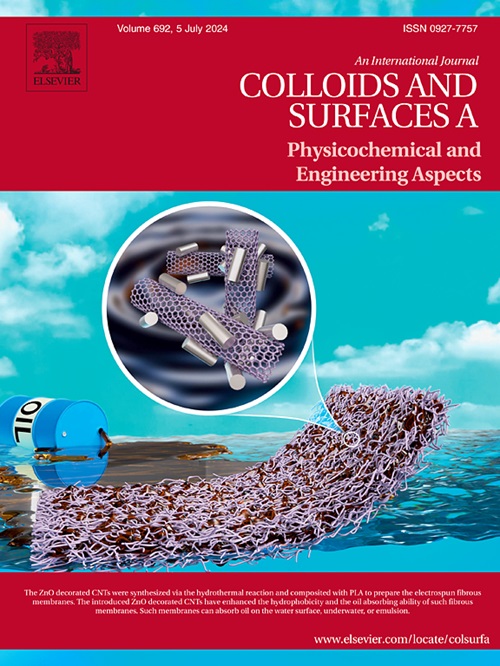Size-tunable gold nanosphere superlattices with enhanced SERS performance
IF 5.4
2区 化学
Q2 CHEMISTRY, PHYSICAL
Colloids and Surfaces A: Physicochemical and Engineering Aspects
Pub Date : 2025-07-16
DOI:10.1016/j.colsurfa.2025.137761
引用次数: 0
Abstract
Nanoparticle superlattices of varying sizes are of great significance for applications in electronic and plasmonic devices, as well as optical metasurfaces. In this study, large-sized gold nanospheres were synthesized through a seed-mediated method, and then functionalized with thiol group. Large-area monolayer superlattices were then self-assembled at the liquid -liquid interface. By varying the seed concentration, gold nanospheres with tunable diameters and ultra-smooth surfaces were obtained. The optical properties of these superlattices were investigated through reflectance and transmittance measurements, along with finite-difference time-domain (FDTD) simulations. The monolayer superlattices can be served as high-sensitivity Surface-Enhanced Raman Scattering (SERS) platforms, exhibiting a high density of electric field hotspots. As the particle size increased, the intensity of localized surface plasmon resonance (LSPR) also enhanced. Additionally, the influence of laser excitation wavelength and probe molecule types and concentrations on SERS response, were investigated. A direct correlation was observed between SERS intensity and probe molecule concentration across five orders of magnitude. Finally, these monolayer superlattices proved to be reproducible and uniformly enhanced substrates, widely applicable in sensing technologies.
具有增强SERS性能的尺寸可调金纳米球超晶格
不同尺寸的纳米粒子超晶格在电子和等离子体器件以及光学超表面的应用中具有重要意义。本研究采用种子介导的方法合成了大尺寸金纳米球,并用巯基进行了功能化。大面积单层超晶格在液-液界面处自组装。通过改变种子浓度,获得了直径可调、表面超光滑的金纳米球。通过反射率和透射率测量以及时域有限差分(FDTD)模拟研究了这些超晶格的光学特性。单层超晶格可以作为高灵敏度的表面增强拉曼散射(SERS)平台,具有高密度的电场热点。随着粒径的增大,局部表面等离子体共振(LSPR)强度增强。此外,还研究了激光激发波长、探针分子类型和浓度对SERS响应的影响。SERS强度与探针分子浓度之间存在5个数量级的直接相关性。最后,这些单层超晶格被证明是可复制和均匀增强的衬底,广泛应用于传感技术。
本文章由计算机程序翻译,如有差异,请以英文原文为准。
求助全文
约1分钟内获得全文
求助全文
来源期刊
CiteScore
8.70
自引率
9.60%
发文量
2421
审稿时长
56 days
期刊介绍:
Colloids and Surfaces A: Physicochemical and Engineering Aspects is an international journal devoted to the science underlying applications of colloids and interfacial phenomena.
The journal aims at publishing high quality research papers featuring new materials or new insights into the role of colloid and interface science in (for example) food, energy, minerals processing, pharmaceuticals or the environment.

 求助内容:
求助内容: 应助结果提醒方式:
应助结果提醒方式:


